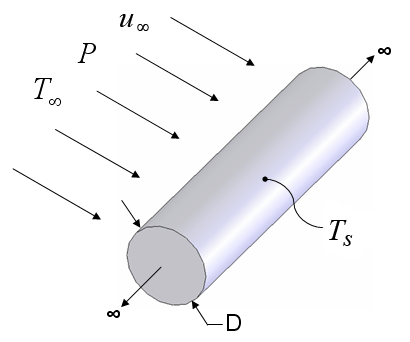
External_Flow_Cylinder

Procedure External_Flow_Cylinder(Fluid$, T_inf, T_s, P, u_inf, D: F_d\L, h, C_d, Nusselt, Re) calculates the average heat transfer coefficient, drag force per unit length of cylinder and the drag coefficient for external flow past an infinite cylinder as presented in White (1991) and section 4.9.3 of Nellis and Klein. Properties are evaluated at the film temperature and the units of inputs and outputs depend on the settings in EES.
Inputs
Fluid$ can be any fluid in the EES data base. The fluid can be an ideal gas, a real fluid, a brine, or an incompressible fluid in the Solid-Liquid_Props fluids library.
T_inf - the free stream fluid temperature in [C], [K], [F], or [R].
T_s - the surface temperature of the cylinder in [C], [K], [F], or [R].
P - pressure can be in [Pa], [kPa], [bar], [MPa], [atm] or [psia]. (Note that for brines, this parameter provides the concentration in % instead of pressure.)
u_inf - free stream velocity of the flow in [m/s] or [ft/min]
D - diameter of the cylinder in [m] or [ft]
L - length of the cylinder in [m] or [ft]
Outputs
F_d\L - drag force in [N/m] or [lb_f/ft]
h - average heat transfer coefficient in [W/m^2-K] or [Btu/hr-ft^2-R]
C_d - drag coefficient [-], which is defined as
![]() ,
,
where Afr is the frontal area,
r is the density
Nusselt - average Nusselt number [-], defined as
![]()
where k is the conductivity
Re - Reynolds number [-], defined as
![]()
where m is the viscosity
Notes
This procedure is responsible for determining the property data of the fluid specified and calculating the Reynolds and Prandtl numbers. This procedure then passes the Reynolds and Prandtl numbers to the non-dimensional procedure External_Flow_Cylinder_ND. The non-dimensional procedure then returns the values for C_d and Nusselt. External_Flow_Cylinder calculates the drag force and the heat transfer coefficient for convection from the Nusselt number and drag coefficient,
Example 1:
$unitSystem SI K kPa J
T_s=328 [K]
Fluid$='air'
T_inf=297 [K]
P=101.3 [kPa]
u_inf=10 [m/s]
D=0.01 [m]
Call External_Flow_Cylinder(Fluid$, T_inf, T_s, P, u_inf, D: F_d\L, h, C_d, Nusselt, Re)
{Solution: F_d\L=0.5849 [N/m], h=107.8 [W/m^2-K], C_d=1.036 [-], Nusselt=40.56 [-], Re=5,897 [-]}
Example 2:
$unitSystem SI K kPa J
T_s=328 [K]
Fluid$='PG'
T_inf=297 [K]
P=101.3 [kPa]
u_inf=.5 [m/s]
D=0.01 [m]
Call External_Flow_Cylinder(Fluid$, T_inf, T_s, 50[%], u_inf, D: F_d\L, h, C_d, Nusselt, Re)
{Solution: F_d\L=1.1372[N/m], h=2987 [W/m^2-K], C_d=1.07 [-], Nusselt=80.9 [-], Re=1723 [-]}